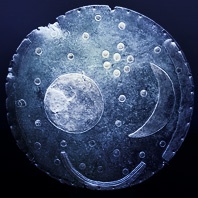The Nebra sky disk

This disk, made of bronze and gold, with an age of around 3,600 years, belongs to the oldest find representing astronomical phenomena and thereby depicting planets and stars in the sky. It is thus of great value, because it is evidenced that people of the Bronze Age (2200-800 BC) did not only possess manual skills to create such a refined metal disk, but above all, had the knowledge about astronomical processes. They observed the celestial events with the naked eye and portrayed this in an artistic form.
The Nebra sky disk (Nebra is a small town in Saxony-Anhalt, Germany) has a colourful history. Due to a variety of material analyses, in particular of the associated finds that were discovered together with the disk, it was possible to determine the approximate time of burial to be 1600 BC, and hence the age could be defined. This precious piece lay in the ground in Nebra over millennia until in 1999 it was found by tomb raiders. After sales from fence to fence and many efforts, it found its way back and was turned into government property. Subsequently, if became the most substantial research object and remains to be the most valuable item of the Bronze Age, until today. The insurance value is over 100 Mio. Euros – a striking figure for two kilos of old metal.
The disk has a diameter of 32 centimetres. One can see on its bronze body (an alloy of copper and zinc), which is now covered with a green layer of malachite, different applications of gold that depict the night sky. On the left side of the centre, there is a big circle that used to be interpreted as the Sun. Today, it is also potentially seen as the Full Moon – which makes sense, considering the simultaneously depicted stars. Furthermore, you can see the waxing moon crescent and various stars, of which the central formation is being interpreted as the Pleiades, see also the following picture:

Sideways, on the edge of the disk, arches were attached (only the one on the right remained preserved), which mark the horizon and hence, the sun rise and sun set. The smaller arch on the lower edge represents a solar barge that we know of the Egyptian mythology. This boat was supposed to carry the sun at daylight across the sky, in order return driving through the underworld at night.
It is interesting that the moon crescent has clearly a bigger diameter in comparison to the full moon or sun disk. Because the moon crescent lies closer to the horizon, this could be an indication of the so called moon illusion, a phenomenon where the Moon appears to be larger when closer to the horizon.
The Nebra sky disk is an impressive example for the power of the human mind and its need to research and understand the world and the universe. Much of this power remained alive in our time and reminds us not to stagnate. We are able to do great things.

Photos: WIKIPEDIA, NASA
P.S. Whilst writing this article, the spell checker always changed »Nebra« to »Zebra«. So, if you should come across a striped, hoofed animal, it would not be our fault 😉

You can learn about the Sky Disc’s astronomy in the planetarium of the visitor centre Nebra Ark at the foot of Mittelberg hill. The centre reveals further dimensions of this famous discovery in a multimedia presentation of the Sky Disc’s history. The original discovery spot is also revealed and explained to visitors. Audioguides in English available! More information (unfortunately only in German at the moment): http://www.himmelsscheibe-erleben.de